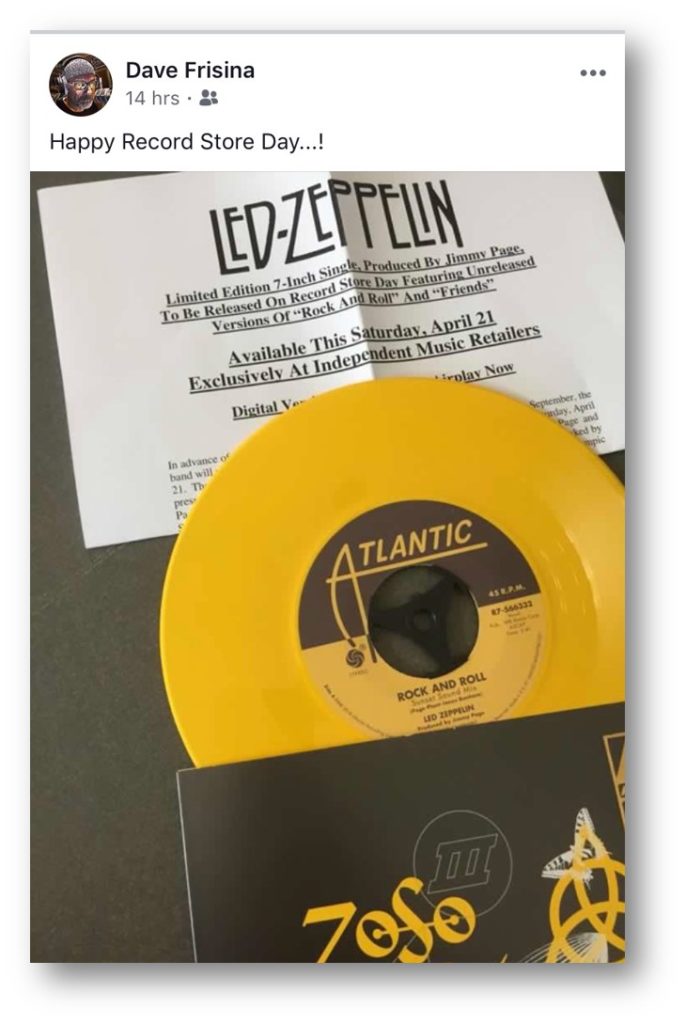 Perhaps you missed National Record Store Day this past Saturday. If you were hanging out on social media over the weekend, you probably saw posts and tweets like the one above from music/radio maven, Dave Frisina.
Perhaps you missed National Record Store Day this past Saturday. If you were hanging out on social media over the weekend, you probably saw posts and tweets like the one above from music/radio maven, Dave Frisina.
Many Rock and Classic Rock stations paid tribute to National Record Store Day over the weekend, a quaint reminder of music appreciation days gone by. Or perhaps it’s an event that symbolizes the comeback of the experiential, the tactile, the touch that comes with enjoying culture.
This manufactured holiday has become a big deal for record labels, the artists who make music, and of course, the hardy souls who have fought the odds and own record stores. It’s been a tough few decades, starting with the advent of the CD and other digital media in the ’80s. But now as the compact disk sets in the west, no longer the music medium of choice, vinyl finds itself continuing to make a comeback.
I always think about the desperate character, Rob Gordon (played by John Cusack) who owned the record store in the 1999 film, “High 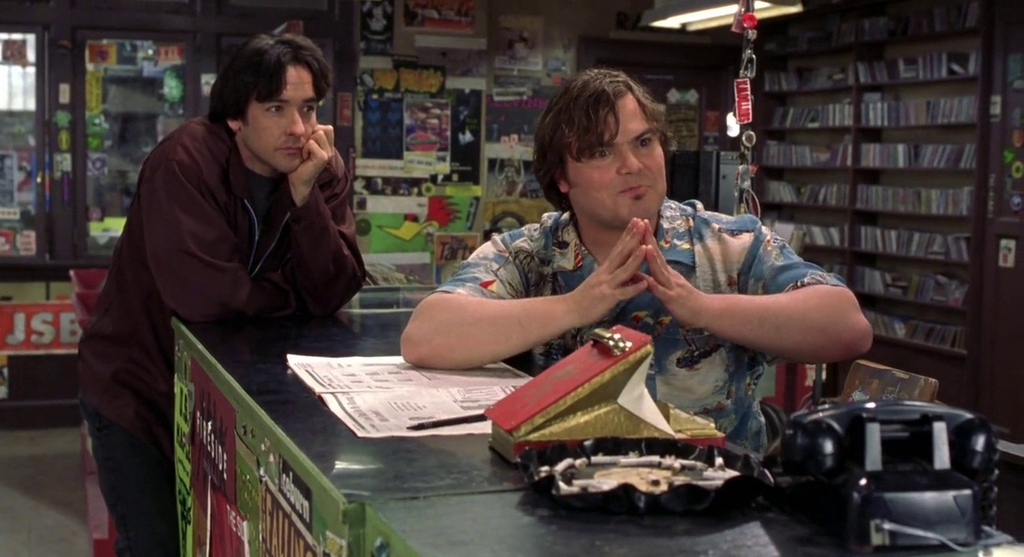 Fidelity.” He was always making “Top 5” lists (including his breakups) – the ongoing theme of the film that revolved around the reality that Rob’s life was going nowhere. But “High Fiedlity” also showed off the quirky charm and romance of the neighborhood record store, including some of the odd savants who work there (played brilliantly by then-newcomer Jack Black and Todd Louiso).
Fidelity.” He was always making “Top 5” lists (including his breakups) – the ongoing theme of the film that revolved around the reality that Rob’s life was going nowhere. But “High Fiedlity” also showed off the quirky charm and romance of the neighborhood record store, including some of the odd savants who work there (played brilliantly by then-newcomer Jack Black and Todd Louiso).
But things have turned around for record store owners since the film was released nearly 20 years ago. The Statista chart below, featuring Nielsen data, shows the uptrend for vinyl music sales – a stready growth trajectory that continues to impress – and even amaze. Of course, 14 million units sold annually is still a blip on the screeen. But perhaps it’s an indicator of a larger trend we’re continuing to see, especially in the research our company conducts.
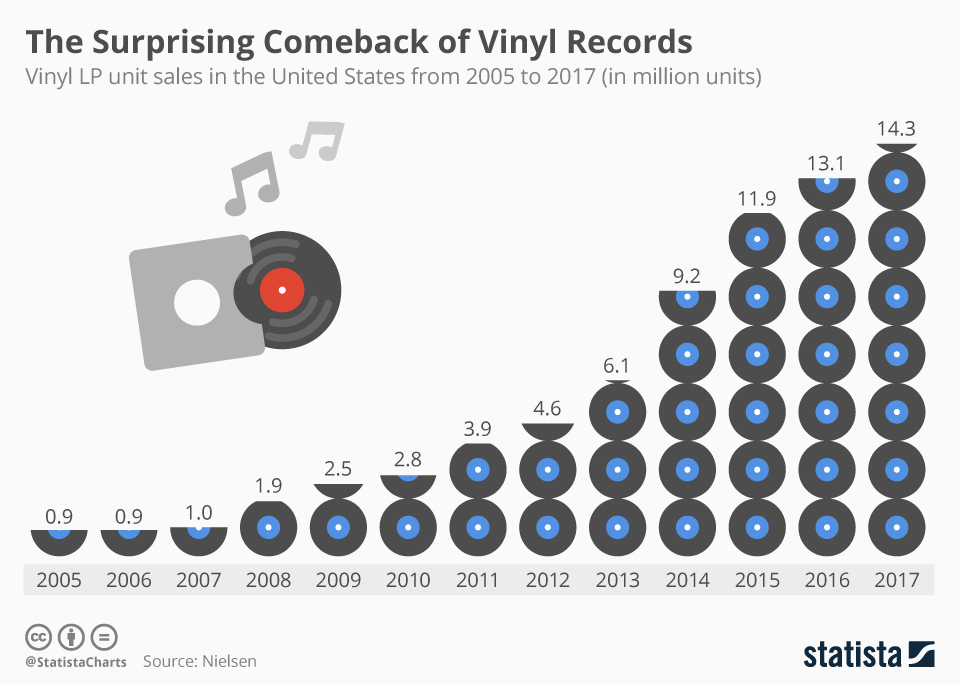
Consider that more people own a turntable that plays vinyl records than own an Amazon Echo, an Apple Watch, or a virtual reality headset.
We continue to track turntable ownership in our Techsurveys, and this chart from our soon-to-be-released 2018 study shows that while levels are holding steady, about a third of respondents have one of these antiques in their homes, apartments, or dorm rooms.
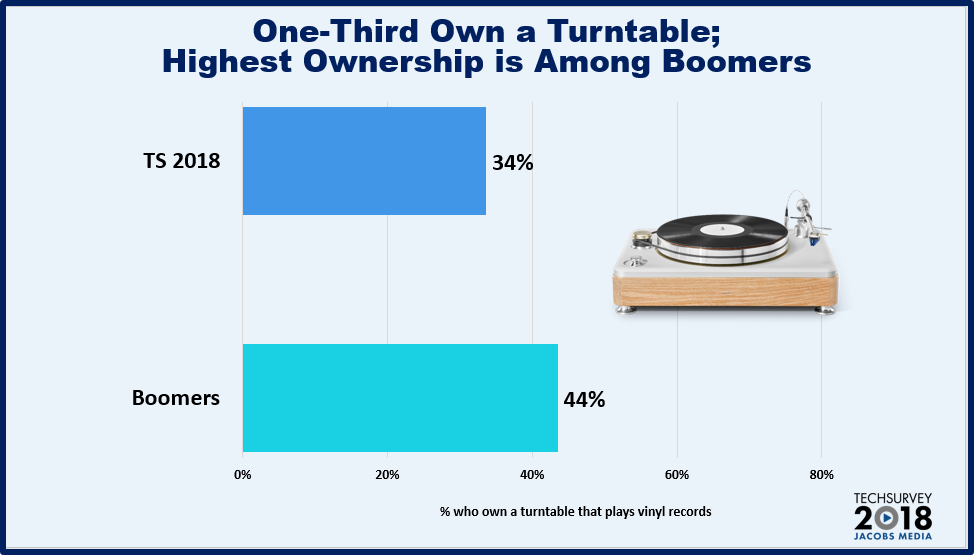
While Boomers lead the way, about one-fifth of Millennials tell us they own a turntable, too. And that speaks to perhaps a larger trend that may, in fact, be something of a backlash against digital media – CDs, Mp3s, ebooks, and the other conveniences that have turned media into impersonal commodities that lack artwork and tactile stimulation.
Culture becomes files in a directory to be sorted, shuffled, catalogued, and skipped. That’s a long way from art.
There is something still special about cracking open the latest Malcolm Gladwell book or gently setting the tone arm down on a copy of the remastered edition of the Beatles’ “Sgt. Pepper’s Lonely Hearts Club Band” album. We saw this phenomenon at a number of Millennial households we visited in our recent ethnogrpahic study conducted for PRPD and a group of 15 public radio stakeholder stations. Many of these young people owned turntables, and were building collections of record albums, proudly displayed in a living room or den.
The same thing is happening at the retail level where Amazon has changed the way people shop. The company recently reached a milestone – the 100 millionth Prime customer, as their shopping empire expands well beyond the U.S. We’re not far from the eventuality where we won’t have to set foot in the mall or carry a package home. Drones will deliver our boxes with little smiles on them:
Does this mean shopping or dining out will become obsolete in the next several years, thanks to services like Amazon Prime Air? Will we simply “1-Click” order everything from diapers to snow shovels to dinner – all delivered within minutes thanks to brilliant Amazon logistics?
Or will retailers – whether it’s record store owners, malls, department stores, and restaurants – have to step up and provide great service, memorable experiences, and a social context that makes these activities more fun than selecting items on a touch screen and waiting for them to be drone-delivered to our doors?
That high-touch connection to technology – or even people – is something that will become even rarer, as more artificial intelligence, algorithms, and location technology pervades our existence. And so, it would seem that an obvious backlash is about owning, using, handling, and yes, cherishing the tactile pleasures one gets from commuming with “old school” technology – books, records, and perhaps the ability to continue to drive our own cars.
A few months back, we moved into a new condo. My first purchase? A new turntable. My late twentysomething daughter dropped by to help us get unpacked. And she earned the assignment of alphabetizing the vinyl albums. It was fascinating to hear her react to many of them. She was familiar with the artists, of course, but had never seen the albums some of her favorite songs are from.
Once that task was accomplished, it was time to play that first album (Steely Dan – “Aja”). I ended up showing her how to handle an album, carefully taking it from its sleeve, placing it on the turntable, and then positioning the tone arm on Side A, Song 1. It was like a demonstration of how to handle the Dead Sea Scrolls – a sacred practice devoted to the care and handling of a vinyl record.
I then handed her the album jacket so she could check out the artwork, photos, and other materials that once accompanied a collection of songs known as an album.
But what happens when cutting-edged technology actually helps bring fans more in touch with art and the world around them?
Same daughter, last week. She gets tickets for the Jack White show at the new Little Caesars Arena in downtown Detroit. Tired of fans staring at their phones throughout his concerts, White has moved to a new technology called Yondr throughout his entire concert tour. Fans can either leave their phones in their cars (as my daughter chose to) or place them in special pouches at the arena. To unlock them to make a call (or check sports scores or whatever), concertgoers have to return to a designated Yondr zone to have their pouches unlocked.
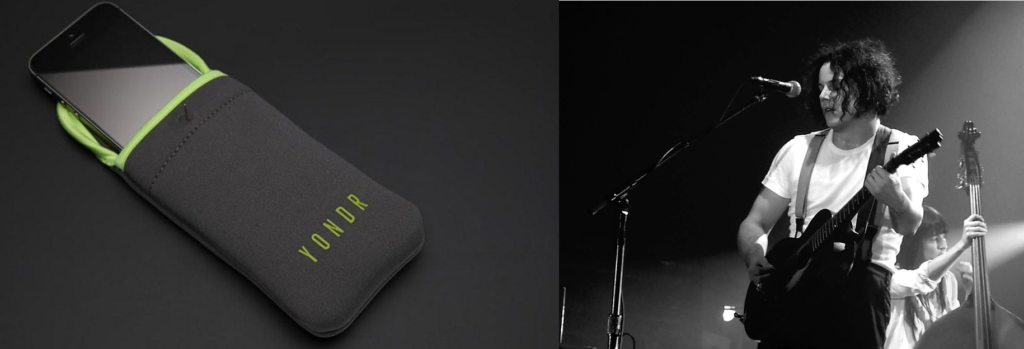
It should be noted that White has his own label – Third Man Records – and a Detroit-based headquarters with a vinyl pressing plant in the back. This guy doesn’t just talk the talk. He is most certainly walking the walk.
So, the big question: What it was like to attend a concert without her iPhone?
She told me that once you reconcile yourself to the fact you don’t have your phone with you, you actually focus on the show itself, listening to all the songs, watching the performers on stage, and taking in the sights and sounds going on around you – without taking snaps, without shooting video, and without texting with you former roommate from Ohio. Yes, it was like attending a concert in the ’60s, ’70s, or ’80s. You watched the concert and were aware of the crowd around you.
It’s a case of a new tech company (Yondr is a Bay Area startup) developing a product that facilitates high-touch enjoyment of a performance. Ironically, we now need tech to help us appreciate the very real, tactile world around us.
High-tech makes it possible to experience high-touch.
As White explained to Rolling Stone, “If (the audience is) not really there, I don’t know what to do next.”
We’re there.
- Like A Pair Of Old Jeans - April 2, 2025
- What’s Fair Is Fair - April 1, 2025
- What’s On Your Bucket List? - March 31, 2025




I love this! My GM and I drove about an hour away for the closest RSD Store in Marshalltown, Iowa. We were both excited for the special releases and seeing this “new” record store in person (it was a store for years right next door to where they JUST moved in, rebuilt and opened JUST in time for Record Store Day). There was a line in front of the store, as we suspected, and the vibe was that everyone was excited about the doors opening. It really IS an event.
I have a vinyl blog/vlog that I do once a month and this week, I will be posting the newest update. I’m focusing on RSD. The history of it, why it’s a really big deal and why vinyl (with the help of RSD) is “Killing the MP3 industry – One revolution at a time” (taken from a bumper sticker I own.
Thanks so much for this blog, sir. You and I have the same “First spin” album, Aja. The recording and mastering of this record set the bar very high for sound in 1977. I still don’t believe it has been equaled.
Shawn, thanks for the kind note and insights. Great story about that record store in Iowa (I lived in Cedar Rapids once). Pelase send me a link to your blog when it goes live.
Many thanks, and enjoy “Deacon Blues” (perhaps my all-time favorite).
Hi Fred.
That trip I took with Shawn was a hoot. I hadn’t seen many true record stores in years. Sam Goody, Strawberries, Tower, Musicland, they’re all gone.
So, with a renewed interest in vinyl, I fired up a late 1970s Technics turntable I got from one of my radio stations and began RE-buying all the vinyl I somehow let go when CDs exploded.
That Led Zep single release shown above is one thing I bought. Along with the “new” Jimi 7″ single. And I did find a clean original copy of “Deja Vu.” Love this stuff! It was a fun ride-along with KOKZ afternoon drive guy and vinyl aficionado Shawn Foxx.
Jack
It’s nostaglic but yet a very cool thrill to drop that tone arm on a great record. It’s a different way of enjoying music that is very tactile after decades shuffling digital files. Thanks for telling your story, Jack.
Great, fun read, Fred! I love all the new technology, but if any of it can complete with the sheer anticipation that fills the room the moment you drop the needle on that Marantz turntable, I haven’t heard it! And to think NEW technology is being used to bring us back to the OLD technology! Oh, the iRony!
It is an interesting twist, isn’t it? Thanks so much, David.